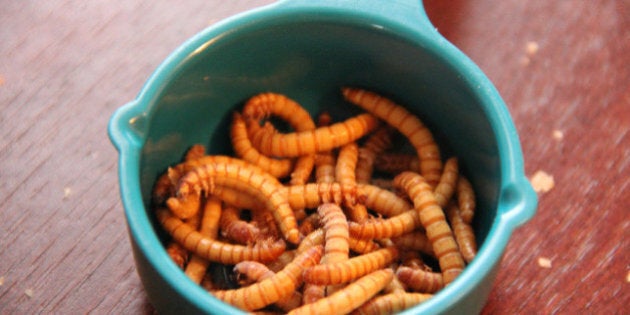
I inadvertently ate a worm that was living in my cereal, I think. It was squirming, really. Which grossed me out beyond words but it got me to thinking...what are the dangers lurking in our cupboards? Are mealworms like the ones that ruined my snack dangerous parasites? What about those annoying food moths? What if you swallow those? Here is the lowdown on the bugs in your cupboard and what to not to and what to definitely worry about.
(And yes, I am swallowing hard to keep the nausea low, just like you.)
Mealworms
Mealworms, like the one I may or may not have eaten, live in larvae form in cereal grains until they can eat enough of your hard earned cereal to become beetles. It takes two beetles to fertilize and lay the 500 eggs that can hatch within four to 19 days. Your cereal may have been packed with fertilized eggs so don't feel you need to go looking for the beetles making whoopee in your pantry. Once they hatch into larvae, they can crawl from box to opened box and set up shop.
If you eat one
Not to worry. They are actually considered food in many parts of the world with their high protein content. There appears to be no adverse affects of eating one live other than the ick factor.
What to do
You will want to throw away any opened boxes in that and/or nearby cupboards. Or, take the risk that no eggs were laid in nearby boxes and just comb through for wiggles.
Cupboard moths
You may begin to see a tiny, papery beige moth or two fluttering about the kitchen. This should drive you to search your pantry for an infestation before it grows. These tiny pests can spread quickly once they hitch a ride to your house from a store with its own infestation. These tiny moths start as larvae in dry goods like cereal, rice, nuts, dried fruits and grains. You may spot clumping and webbing which will indicate eggs.
If you eat one
Not to worry. They won't multiply or become parasites, the human gut is a hostile environment. (Thank goodness!)
What to do
This problem requires a thorough cleaning with removal of all open packages, twist off lids and crevices. A good scrub and vacuum should remove any of the pervasive pests but you may want to place all remaining packages in zipper freezer bags and or the fridge. It could take a couple of weeks for the life cycle to show you if you missed any.
Roundworms and tapeworms are two that can (in fact, can only ) live in a host's (that's you!) intestine. Unlike the worms in your cupboard, these two live on animal/fish protein and survive refrigeration and must be fully cooked to kill . Raw food, no matter how "safe" it appears can be at risk because the worms are not visible to the naked eye. Symptoms of infection can vary from absolutely none to cramps, discomfort, diarrhea and malnutrition.
What to do
If you are a regular wild game consumer, sushi, tartar or other raw food eater, you may want to get a fecal sample test. Otherwise, ignore this post and cook your food fully.
There. Now I feel better, if appetite free, just knowing what to worry about versus what is simply gross.
MORE ON HUFFPOST:
